Exploring Vodka: Innovative Alcohol Recipes
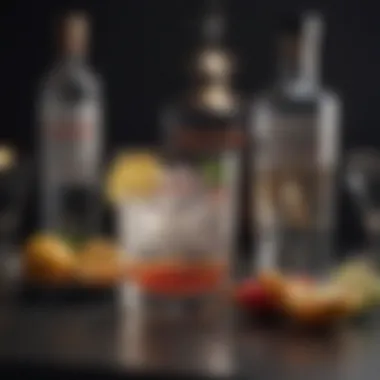

Intro
Vodka stands as one of the most versatile spirits available today. Its neutral flavor allows it to mix seamlessly into countless cocktails and infusions, making it a staple in bars and homes alike. This article aims to uncover various vodka recipes that blend traditional methods with modern creativity, offering something for both novice mixers and experienced cocktail enthusiasts.
In recent years, the way vodka is perceived has shifted dramatically. It is no longer simply a base for classic drinks. Instead, innovative blending and infusion techniques are breathing new life into this spirit, allowing for unique flavor profiles that delight the palate. By examining these methods, we can uncover both sophisticated offerings and fun, quirky twists that elevate vodka beyond a mixer.
Through careful exploration of recipes and techniques, readers will gain insights into how to best utilize vodka in their beverage creations. This article will guide you through the art of mixing, infusing, and ultimately understanding the complexities of this beloved spirit in the context of cocktails and culinary applications.
Furthermore, we will discuss various approaches to creating balanced and enticing drinks that cater to various tastes. Whether you are preparing for a special occasion or simply want to experiment at home, knowing the right tips and techniques can transform your vodka mixing experience.
Prolusion to Vodka in Modern Mixology
Vodka has established itself as a crucial element in modern mixology. It is not just a spirit; it is a canvas for creativity to alcohol enthusiasts and professional bartenders alike. The versatility of vodka allows it to blend harmoniously with numerous flavors, making it a popular choice in cocktail creation. As consumers become more discerning in their drinking choices, understanding the role of vodka in this context becomes essential.
In this article, we will explore various aspects of vodka in mixology, highlighting its global appeal, different varieties, and selection tips.
The Global Appeal of Vodka
Vodka stands out due to its wide-ranging popularity across the globe. It is a staple in many countries, each adopting unique traditions and flavor profiles that enhance its appeal. Eastern Europe, particularly Russia and Poland, is renowned for its vodka culture, where it is often consumed neat. However, the West has embraced vodka as a key ingredient in mixed drinks, expanding its reach.
This global appeal can be attributed to vodka's neutral flavor, which allows it to complement various ingredients, from fruit juices to herbal infusions. Additionally, many brands have emerged, each offering distinct characteristics, thereby allowing consumers to experiment with different varieties. This adaptability not only aligns with the modern trend of personalization in cocktails but also encourages creativity.
Vodka Varieties and Selection
When selecting vodka for mixology, understanding the different varieties is important. Vodka flavors can vary widely based on their ingredients and production methods.
- Grain Vodka: Commonly made from wheat, rye, or corn, grain vodkas are popular for their smoothness and subtle sweetness. Brands like Grey Goose exemplify this category, showcasing clarity and a crisp finish.
- Potato Vodka: Known for its creamy texture, potato vodka has a rich mouthfeel. It tends to have a more earthy flavor profile, which can bring depth to cocktails. Examples include Chopin.
- Flavored Vodka: Many brands experiment with infusing vodka with fruits, herbs, or spices. This category allows for endless possibilities in cocktail creation, appealing to those who seek unique tastes. Popular choices can include vanilla and berry-infused vodkas.
When choosing vodka, consider the intended use. For cocktails that demand complexity, seek out more flavored varieties. For classic cocktails, select a high-quality plain vodka that will not overpower other ingredients. Brands like Belvedere and Tito's Handmade Vodka are trusted names known for quality and versatility in crafting cocktails.
Essential Tools for Crafting Vodka Cocktails
Creating exceptional vodka cocktails requires more than just quality spirits. The importance of having the right tools cannot be overstated. Essential tools not only enhance the mixing experience but also ensure that the final product is both aesthetically pleasing and flavorful. Knowing how to use each item effectively can elevate a simple drink into a sophisticated creation.
Mixing Equipment
To start, having the right mixing equipment is foundational in cocktail making. Here are the key items to consider:
- Cocktail Shaker: A good shaker is crucial. The classic Boston shaker, which consists of two parts, enables better mixing and chilling of ingredients. Using a shaker helps achieve the desired consistency in texture and temperature.
- Mixing Glass: For drinks like a vodka martini that benefit from a gentle stir, a mixing glass is essential. This allows for controlled mixing, maintaining the drink’s clarity and preventing it from becoming overly diluted.
- Muddler: If your cocktail recipe includes fruits or herbs, a muddler is necessary to release their oils and flavors. Choose a muddler made of wood or plastic to avoid scratching your glassware.
- Jigger: Precision is key in cocktail measurement. A jigger helps measure spirits accurately, ensuring balanced proportions in your drinks.
- Strainer: After shaking or stirring, a strainer is used to pour the liquid while keeping solid ingredients back. This step is critical for maintaining presentation and texture.
By understanding and utilizing these tools effectively, you create an environment that encourages experimentation and mastery of your vodka cocktails.
Garnishing Techniques
Presentation plays an important role in mixology. Garnishing techniques accentuate the visual appeal, making a simple drink look elegant and refined. Here are several effective approaches:
- Twists and Zests: A citrus twist can add aroma and a touch of brightness. Simply use a knife or a peeler to create a thin strip of peel, ensuring to express the oils over the drink before placing it in the glass.
- Fresh Herbs: Utilizing fresh herbs like basil or mint can infuse a cocktail with aromatic quality. Muddling herbs releases their flavors, making sure they complement the vodka.
- Edible Flowers: For a sophisticated garnish, consider using edible flowers. They add a splash of color and a unique element that can delight the senses.
- Olives or Jerky: For savory drinks like the Bloody Mary, garnishes like olives or even beef jerky can add texture and further flavor, creating a more cohesive drinking experience.
"The right garnish doesn’t just make the drink look appealing; it also enhances the flavor profile and experience."
In summary, having an array of essential tools will set the foundation for crafting memorable vodka cocktails. Whether you are a novice or an experienced mixologist, understanding the equipment and garnishing techniques expands your ability to innovate and delight. With the right approach, each cocktail can be a masterpiece.
Classic Vodka Cocktails Revisited
Classic vodka cocktails hold a significant place in cocktail culture, providing a time-tested framework for mixing drinks that appeal to various palates. This section revisits well-known recipes, demonstrating how they can be adapted and enjoyed with modern twists. Such cocktails not only showcase the versatility of vodka but also reveal the sophistication inherent in their preparation. By exploring these classics, readers can appreciate more than just the flavors; they gain insight into the history, craftsmanship, and creativity involved in mixology.
Understanding classic cocktails is essential for any aspiring bartender or cocktail enthusiast. They serve as both a foundation and a platform for innovation. A solid grasp of these classics allows for experimentation while ensuring balance in flavors and textures.
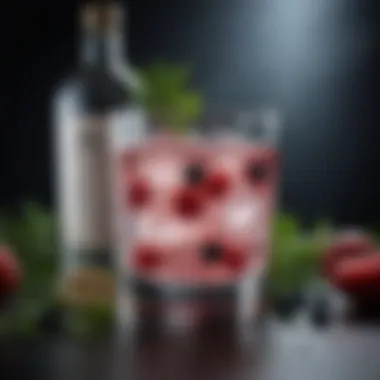
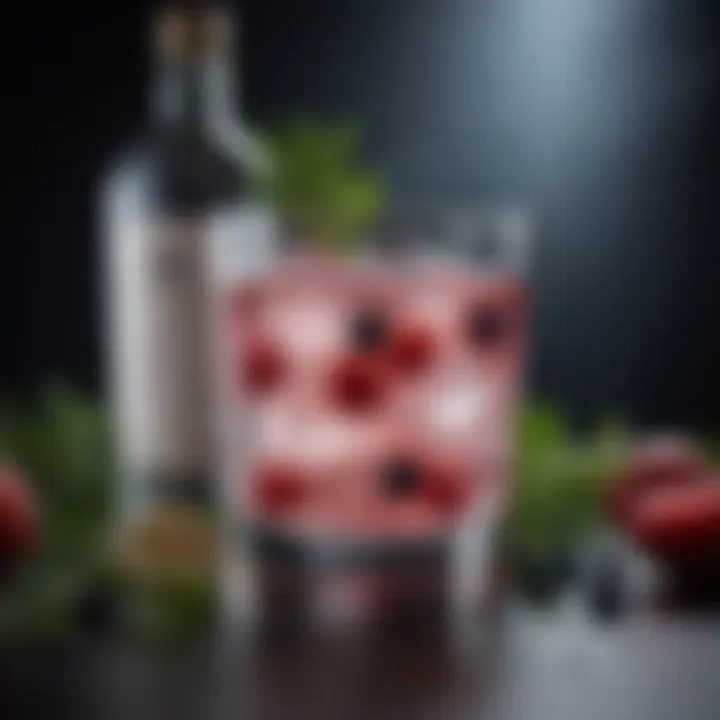
The Vodka Martini
The Vodka Martini is an iconic cocktail known for its simplicity and elegance. Made with vodka and dry vermouth, it is often served up in a classic martini glass. The drink's appeal lies in its clean taste and swift preparation, making it a favorite in cocktail bars worldwide. Key considerations include the quality of the vodka and the ratio of vermouth used. Traditionalists might prefer a more generous pour of vermouth, while others enjoy a drier version.
Garnishing options often include olives or a twist of lemon peel, each adding their own unique flavor profiles to the drink. Experimenting with different vodka brands can also enhance the overall experience, highlighting the spirit's differences. A well-crafted Vodka Martini can serve as a benchmark for understanding the fundamentals of cocktail making.
Bloody Mary Variations
The Bloody Mary transcends its role as merely a brunch staple. Its complex flavors and bold ingredients make it a cocktail for all occasions. Typically comprised of vodka, tomato juice, and various spices, the cocktail can be tailored to personal taste. Popular variations include the addition of ingredients such as horseradish, Worcestershire sauce, and hot sauce. These elements allow drinkers to customize their experience according to preference.
Aside from flavor, the Bloody Mary presents a unique visual aspect with the addition of garnishes like celery sticks, pickles, or even bacon. Crafting the perfect Bloody Mary becomes an art form, mixing flavors, adjusting spice levels, and presenting it beautifully.
Screwdriver and Its Adaptations
The Screwdriver epitomizes the simplicity of cocktail construction. A blend of vodka and orange juice, its origin traces back to the early 20th century. While the original serves as a refreshing choice, modern adaptations can be quite imaginative. Variations might include flavored vodka or switching out the orange juice for other fruit juices like grapefruit or pomegranate.
This drink's base allows for a multitude of interpretations based on seasonal ingredients or unique syrup additions. The Screwdriver remains relevant not just for its ease of preparation, but also as a canvas for creativity in flavor. Many cocktails can trace their lineage to this basic formula, representing a fundamental aspect of mixed drinks.
"Classic cocktails are not just recipes; they are reflections of culture, creativity, and tradition in the world of spirits."
Through revisiting these classic vodka cocktails, readers gain insight into their structure and potential. This exploration provides a gateway for further experimentation, which enriches the cocktail landscape.
Infusing Vodka: Techniques and Tips
Infusing vodka is a creative process that can greatly enhance the flavor profile of this spirit. The methods by which vodka can be infused open pathways to explore and create drinks that are not only flavorful but also personal. This section discusses why vodka infusion is relevant in today's cocktail culture, highlighting specific benefits, key considerations, and useful techniques. Infusion provides a way to incorporate unique ingredients that reflect individual tastes and preferences, allowing one to craft customized cocktails that stand out.
Choosing Ingredients for Infusion
Selecting the right ingredients is critical when infusing vodka. The ingredients will determine the essence of the resultant beverage. Here are some points to consider:
- Freshness: Always opt for fresh fruits, herbs, and spices. The freshness of ingredients will directly affect the flavor outcome.
- Balance of Flavors: Consider how the flavors will intermingle. For example, pairing citrus fruits with herbs can provide a refreshing balance.
- Seasonality: Seasonal ingredients often taste their best. Using ingredients that are in season can enhance the quality of the infusion.
- Quality of Vodka: The base vodka should be of good quality. A clean, neutral vodka serves as the perfect canvas for your flavors, ensuring that the infusion results in a well-rounded beverage.
Infusion Processes Explained
The process of infusing vodka is relatively simple, yet it requires patience and attention:
- Preparation: Before beginning, wash your ingredients thoroughly. For fruits, remove any peels or seeds as necessary. Chop them into small pieces to increase the surface area, allowing flavors to release more effectively.
- Combination: Place the prepared ingredients into a clean jar or bottle, filling it to about one-third to one-half full. Then, pour vodka over the ingredients until they are fully submerged.
- Steeping: Seal the jar tightly and store it in a cool, dark place. The duration of the infusion can vary significantly depending on the ingredients used. Generally, the infusion can take anywhere from one day to multiple weeks. Regularly check on the infusion process, tasting along the way to gauge flavor development.
- Straining: Once the desired flavor is achieved, strain out the solid ingredients using a fine mesh strainer or cheesecloth. This will leave you with a clear, infused vodka.
- Storage: Store the infused vodka in clean bottles and label them with the infusion date and ingredients. Keep in mind that infused vodka does not typically require refrigeration, but it should be stored away from direct sunlight.
Tip: If you wish to make a larger batch or experiment further, scale up your quantities while keeping the same ratios of solid ingredients to vodka.
Infusing vodka not only exemplifies exploration in the realm of mixology but also encourages one to engage creatively with various flavor profiles. This process connects people with their ingredients, allowing for varied and unique cocktail experiences.
Contemporary Vodka Mixology
Contemporary vodka mixology represents a significant evolution in the way vodka is perceived and enjoyed. As a versatile spirit, vodka can serve as a blank canvas for intricate flavors and innovative combinations. The rise of craft cocktails has driven a renewed interest in mixology, where bar professionals and home bartenders seek to create drinks that are not only flavorful but also visually appealing and unique in their presentation. This section explores the intricate details involved in crafting distinctive vodka cocktails and the importance of experimental pairings.
Crafting Unique Cocktails
Crafting unique cocktails requires understanding both the foundational principles of mixology and the distinct characteristics of vodka. The key to an amazing vodka cocktail lies in the balance of flavors, textures, and aromas. While vodka is known for its neutral taste, this very quality allows it to absorb and enhance the flavors of the ingredients used.
Some elements to consider when crafting unique vodka cocktails include:
- Base Ingredients: Select fresh produce, herbs, and spices that complement the vodka without overpowering it. Citrus fruits, berries, and aromatic herbs often work well.
- Textures: Incorporate different textures through the use of sparkling water, fresh juices, or even foams. This adds depth to the drinking experience.
- Presentation: Consider garnishes that not only enhance the flavor but also add to the visual appeal. A well-presented cocktail can elevate the overall experience.
- Infusions: As previously discussed, infusing vodka can be a delightful way to create base spirits with unique profiles.
"The beauty of craft cocktails lies in the ability to combine creativity and quality ingredients to produce something truly unique."
Experimenting with these elements can yield extraordinary results. For example, a cucumber and basil vodka cooler may offer a refreshing taste that is perfect for summer gatherings. Or, a passion fruit and ginger vodka punch could serve as a vibrant option for a celebration. Both showcase how diverse and imaginative vodka cocktails can be.


Experimental Pairings
Experimental pairings are at the forefront of contemporary vodka mixology. The aim is to break the mold of traditional pairings and explore unexpected flavor combinations. Vodka's hallmark of versatility opens avenues for exciting culinary experiences.
Here are some fresh pairings to consider:
- Vodka and Spice: Mixing vodka with spicy elements, such as jalapeños or sriracha, can create a memorable kick that surprises the palate.
- Smokiness: Pairing vodka with smoked ingredients, like smoked salt or chili flakes, can introduce an intriguing depth. This contrast often enhances the complexity of the drink.
- Herbal Notes: Experimenting with herbal infusions—such as rosemary, thyme, or dill—can offer aromatic layers that complement vodka’s clean flavor.
- Refreshing Couplings: Strategies such as pairing vodka with bubbly elderflower tonic steam or tart cranberry soda can refresh the senses.
Each of these pairings illustrates how vodka can transcend its traditional roles, evolving into a sophisticated component of modern cuisine and mixology. By daring to explore these combinations, mixologists can continually surprise and delight their audience with something truly innovative.
Health Considerations When Consuming Vodka
When discussing vodka, it is essential to approach the topic with a consideration for health. Vodka, like any alcoholic beverage, can have effects on the body that should not be taken lightly. While enjoying vodka cocktails can be a delightful experience, understanding the health implications is crucial for responsible consumption. This section will explore two key aspects: the concept of Alcohol by Volume (ABV) and the significance of moderation.
Understanding Alcohol by Volume (ABV)
Alcohol by Volume, commonly abbreviated as ABV, measures the percentage of alcohol present in a beverage. Understanding ABV is crucial for those who partake in vodka consumption. Vodka typically has a higher ABV, often around 40%, though some variations may have a higher alcohol content.
Drinking vodka with such a high ABV means that even a small amount can lead to significant effects. For instance, just two standard shots can be quite potent for those who may not have a high tolerance. It's important for consumers to read labels and be aware of the specific ABV of the vodka they choose. This knowledge enables drinkers to make informed decisions about their limits and helps in the prevention of overconsumption. While vodka is versatile, understanding its strength can guide better choices in mixing cocktails.
Moderation and Its Importance
Moderation is often cited as key when it comes to alcohol consumption. For vodka, it becomes even more critical owing to its potency. The negative effects of excessive drinking include not only health risks but also social implications.
In general, guidelines suggest that women should not exceed one standard drink per day. This limits the risk of long-term health issues, such as addiction or liver complications. Drinking responsibly also enhances the overall drinking experience. When enjoyed in moderation, vodka can contribute to social gatherings without overshadowing them with negative consequences.
"Moderation helps maintain a balance between enjoyment and health, ensuring that vodka remains a source of enjoyment rather than a cause for regret."
In summary, understanding ABV and practicing moderation are both essential for a healthy relationship with vodka. Being aware of how these factors influence consumption can make a significant difference in the drinking experience.
Pairing Vodka with Food
Pairing vodka with food is both an art and a science, delving into how flavors interact on a gastronomic level. The versatility of vodka makes it a unique partner for various dishes. When considering what to serve alongside vodka, it’s crucial to recognize its neutral character. Unlike other spirits, vodka’s mild flavor can enhance the natural taste of foods without overpowering them. This quality opens a broad spectrum of culinary possibilities.
In this section, we will explore how vodka can be harmoniously paired with a range of dishes, understanding its role not just as a beverage but as an ingredient in flavor balance. This exploration includes thoughtful considerations about taste profiles and the overall dining experience. The practice of pairing vodka with food encourages creativity and experimentation, leading to new and exciting culinary discoveries.
Complementary Flavors and Dishes
Selecting the right food to accompany vodka can elevate an ordinary meal to an extraordinary dining experience. It is essential to focus on flavors that complement the subtle character of vodka.
Some excellent choices include:
- Cured Meats: The saltiness of prosciutto or salami can beautifully contrast with the smooth taste of vodka.
- Pickled Vegetables: Items like pickled gherkins or beets bring a crunchy texture and a tangy bite, enhancing vodka's clean flavor.
- Seafood: Light dishes such as shrimp cocktail or smoked salmon pair well due to the vodka’s refreshing quality.
- Cheese: Soft cheeses like goat cheese can be a delicious match, providing creaminess that balances vodka’s crispness.
When constructing pairings, think about establishing balance. A dish that is overly rich might be best complemented by a straight vodka, while lighter, more acidic dishes can be attractively paired with flavored vodkas.
Vodka in Cooking: Sauces and Marinades
Vodka isn't just a drink; it can also be a dynamic ingredient in cooking. Utilizing vodka in sauces and marinades can elevate flavors significantly. Its ability to blend well with other ingredients allows chefs to create vibrant dishes with depth and character.
Here are some ways vodka contributes to savory cooking:
- Pasta Sauces: Vodka sauce, popularized by Italian-American cuisine, combines creamy elements with the sharpness of tomatoes, creating a flavorful base for pasta.
- Marinades: Vodka can serve as an excellent base for marinades, helping to tenderize meats while adding a slight complexity to their flavor profile.
- Glazes and Dressings: Incorporating vodka into glazes can accentuate their sweetness and add a layer of sophistication.
Cooking with vodka requires careful consideration of quantity. Too much can introduce alcohol flavors, while the right amount can lend a unique profile that enhances the overall dish.
"Pairing vodka with food offers a realm of culinary opportunities that can transform dining experiences."
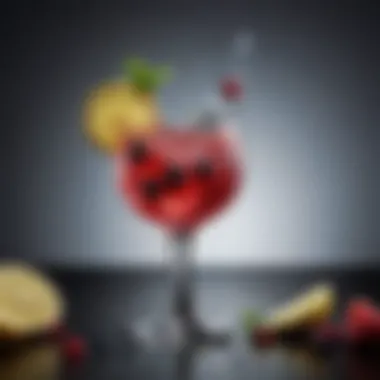
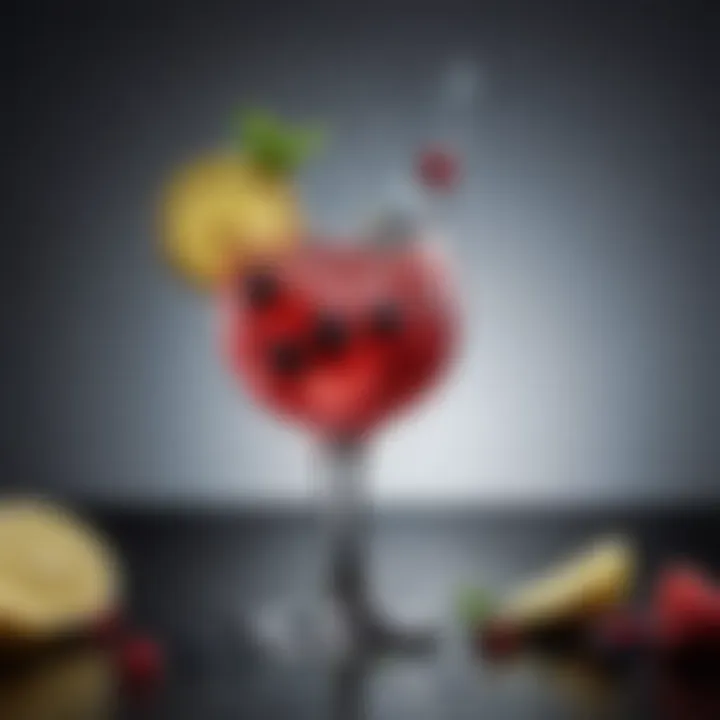
By considering vodka’s diverse applications in both pairing and cooking, we deepen our understanding of this spirit. Whether enjoyed in a glass or incorporated in a dish, vodka's presence enhances flavor dynamics and enriches culinary experiences.
Vodka and Sustainability
In recent years, sustainability has gained prominence across various industries, and the vodka sector is no exception. The production of vodka involves multiple processes that have environmental impacts. Recognizing this, distilleries are making efforts to adopt sustainable practices. This is not only crucial for conserving resources but also for meeting consumer demand for ethical products. By focusing on sustainability, vodka producers can contribute to the health of the planet while appealing to a conscientious market.
Ethical Distillation Practices
Ethical distillation practices are essential for creating vodka with a reduced environmental footprint. These practices include sourcing ingredients locally, using renewable energy, and recycling water used in production. For instance, many distilleries are turning to organic grains or potatoes. This reduces reliance on chemical pesticides and fertilizers, thus protecting local ecosystems.
In addition, some brands emphasize using waste products from food industries. This innovative approach not only minimizes waste but also enhances the flavor complexity of the vodkas produced. By participating in initiatives that promote responsible sourcing, distilleries can also support local economies.
"Sustainable vodka production is about more than just the product; it's about creating a system that respects both nature and the community."
Sustainable Packaging Solutions
Packaging is another significant area for sustainability in the vodka industry. Many distilleries are rethinking their packaging to minimize environmental impact. This ranges from choosing glass bottles made from recycled materials to utilizing biodegradable alternatives. Some brands opt to create refillable bottles that encourage consumers to reduce waste and promote reusability.
Additionally, labeling on vodka bottles is increasingly made from eco-friendly materials. This reflects a broader commitment to sustainability. Brands focusing on transparent sourcing and eco-friendly packaging resonate well with consumers looking for more responsible choices.
Future Trends in Vodka Mixology
Exploring the future of vodka mixology is essential in understanding how this versatile spirit will evolve in both taste and presentation. As the beverage industry grows, the trends we see today will likely shape the drinking experiences of tomorrow. This section focuses on emerging ingredients and innovative serving styles that are beginning to redefine how vodka is utilized in cocktails. These changes not only cater to consumer preferences but also push the boundaries of mixology itself.
Emerging Ingredients
The world of vodka mixology is witnessing a significant shift towards the integration of unique and exotic ingredients. Bartenders today are experimenting with a variety of elements that enhance flavor profiles and create standout cocktails. This trend is crucial as it allows for greater creativity and exploration in drink-making.
- Botanicals: Many mixologists are turning to botanicals such as lavender, rosemary, and hibiscus. These ingredients can add a unique twist to classic vodka cocktails, enriching the taste and offering aromatic experiences.
- Spices: Spices like chipotle or saffron are making their way into recipes, contributing a depth and warmth that traditional mixers often lack. The addition of spice creates an unexpected layer of flavor, inviting drinkers to explore new sensations.
- Fruits and Vegetables: Shifts towards organic and locally sourced produce, such as heirloom tomatoes or artisanal berries, are prevalent. Fresh ingredients not only improve the quality of cocktails but also align with sustainable sourcing trends.
- Craft Syrups: The rise of craft syrups adds another dimension to vodka cocktails. Flavor-infused syrups offer a convenient way to introduce complex flavors like smoked maple or ginger without compromising on quality.
Incorporating these ingredients allows mixologists to cater to the growing demand for unique preparations while appealing to health-conscious consumers.
Innovative Serving Styles
Serving styles in vodka mixology are also evolving. The presentation of a cocktail can significantly enhance the user experience, making it memorable. As more establishments embrace creativity, the following trends are becoming prominent:
- Experimental Glassware: Users find that the vessel in which a cocktail is served influences perception and enjoyment. From smoked glasses to hand-blown designs, unique glassware enhances aesthetics and functionality.
- Interactive Experiences: Some bars now avoid a static menu, opting instead for a dynamic selection that changes based on guest interactions. For example, patrons can choose their infusion or garnish, making a cocktail that is truly personalized.
- Thematic Presentations: Presenting cocktails that tell a story through decoration and garnishes is gaining traction. For instance, a cocktail themed around a seasonal harvest might include fruits sliced in a particular style or garnished with edible flowers relevant to the season.
These innovative serving styles create a more immersive experience for the consumer. By engaging the senses on multiple levels, establishments effectively increase customer satisfaction.
"The future of vodka mixology is not just about taste but also the entire drinking experience. It’s about how ingredients and presentation come together to create something profound."
End: The Ongoing Journey of Vodka Exploration
The exploration of vodka is a multifaceted journey, revealing not only the spirit’s versatility but also its cultural significance across various traditions. This article has delved into essential aspects of vodka's role in modern mixology—from classic cocktail recipes to innovative infusions. Each section highlights techniques, tools, and best practices that empower the reader to approach vodka with a sense of creativity and curiosity.
Vodka is more than just a base spirit; it serves as a canvas for flavor and artistry. Understanding vodka’s unique characteristics—such as its ability to blend without overpowering—is crucial for anyone interested in elevating their cocktail-making skills. An appreciation for this spirit invites experimentation and encourages personal expression through mixing.
In this ongoing journey, many paths remain unexplored. Whether one is revisiting classic recipes or embracing new trends such as sustainable practices or unique pairings, the opportunities for discovery are vast. As consumers become more conscientious about the ingredients and practices behind their spirits, vodka's adaptability ensures its continued relevance.
Summarizing Key Points
Throughout the article, several key themes emerged:
- Global Appeal: Vodka holds a significant position in world spirits, embraced in diverse cultures.
- Versatility in Cocktails: Whether it is a traditional martini or a unique infusion, vodka accommodates a wide range of flavor profiles.
- Health Awareness: An understanding of measurements like Alcohol by Volume (ABV) is essential for responsible consumption.
- Sustainability Initiatives: The modern distillation process increasingly focuses on environmental responsibility, catering to changing consumer values.
Together, these elements offer a comprehensive understanding of vodka in both historical and contemporary contexts.
Encouraging Personal Exploration
There is a profound satisfaction in crafting one’s unique vodka cocktails. Readers are encouraged to explore various ingredients and techniques discussed in this article. Personal experimentation can lead to delightful discoveries, such as finding the perfect infusion combination or mastering a classic recipe that resonates with individual taste.
Joining communities dedicated to cocktail crafting can also enhance personal exploration. Engaging with like-minded individuals on platforms such as Reddit or Facebook can provide inspiration and share valuable insights.
In summary, the journey into vodka mixology is continuous. Each attempt to mix, infuse, or pair vodka not only enriches one’s palette but also contributes to a broader understanding of this adaptable spirit. The importance of maintaining an open mind—alongside a willingness to learn and adapt—ensures that the exploration never truly ends.







